Let’s talk about a hybrid that makes some sense for once.
It’s the 2019 Jeep Cherokee.
Wait. I know. It hasn’t got electric motors – and the only battery it has is the one that starts its gasoline-burning engine. So what’s all this talk about hybrids?
Well, the Jeep is a car-based crossover SUV – just like all the others.
To be specific, it’s based on a front-wheel-drive car (just like the others). In the Jeep’s case, the underthings are Fiat/Alfa’s (Fiat owns Chrysler and Jeep) “compact wide” platform – the same basic platform which was used to make the Dodge Dart and Chrysler 200 as well as the Alfa Giulietta sedan.
Being based on a front-wheel-drive car is what defines a crossover SUV. It’s what makes crossover SUVs space-efficient inside – because most of the bulk of the engine and transmission is hunched up sideways over the front wheels, where it’s not intruding into the passenger compartment. Even when all-wheel-drive is added to the mix there’s no massive solid rear axle (and heavy-duty rear suspension) protruding upwards into the passenger compartment – which allows more space for back seat leg and cargo room.
This, plus a more car-like ride (and handling) is what has made crossovers so appealing to so many people who like the looks, the roominess and versatility of a truck-based, traditional SUV but don’t really want an SUV.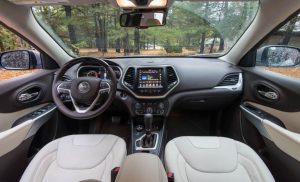
SUVs aren’t as space efficient, because the engine is mounted front-to-back and does intrude into the passenger compartment, eating up interior space.
SUVs also have or offer heavy-duty four-wheel-drive systems, which means bulky two-speed transfer cases, rear axles and heavy-duty suspensions. These eat up more space and add more weight. Which is acceptable if you need the capability, but many people don’t.
Hence the popularity of car-based crossover SUVs.
But what if you could have the practicality of a car-based crossover and the capability of a real-deal 4×4 in the same vehicle?
Presto!
And yes, really.
This Jeep may be a car-based crossover SUV – but it can do most of the things a comparably-sized, truck-descended (or similarly designed) SUV can do. And things no other car-based crossover can.
That makes it my kind of of hybrid.
Maybe yours, too.
The Cherokee is a medium-small, five-passenger crossover SUV in the same general class as models like the Ford Escape, Honda CR-V, Toyota RAV4 and Subaru Forester, among many others.
But the Jeep can go places they can’t – and do things they aren’t capable of doing.
It can rock crawl – thanks to an available gear-reduction system that’s functionally very similar to a 4×4 SUV’s two-speed transfer case.
Really tow.
As much as 4,500 lbs. – which is about 1,500 lbs. more than the next-strongest car-based crossovers can generally deal with and nearly as much as a truck-based SUV of the same size can handle.
Base price is $23,995 for the front-wheel-drive Latitude trim with 2.4 liter four cylinder engine paired with a nine-speed automatic. You can opt for a big V6 – another thing most of its rivals don’t offer – for $1,745 on top of that.
Or – new for 2019 – a high-performance 2.0 liter turbocharged four that makes more power than the V6 but gets better gas mileage than the base four.
It’s available as an option in all but the base Latitude trim.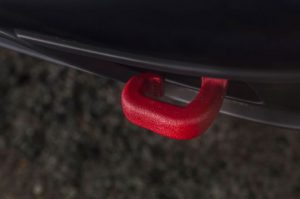
You can also go with one of two four-wheel-drive systems – Active Drive I and Active Drive II. The latter comes with low range gearing, a 51.2:1 crawl ratio and a mechanically locking (not electrically locking) rear differential.
Trailhawk versions – which are the most rugged (“trail rated”) versions of the Cherokee – come standard with the Active Drive II system plus a locking differential, an extra inch of ground clearance, tow hooks, skid plates, 17-inch M/S-rated tires, fender flares and more aggressive approach and departure angles.
These start at $33,320 and come standard with the V6. The turbo four is optional.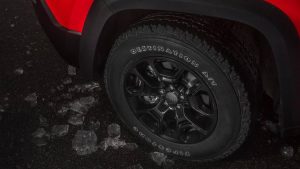
A top-of-the-line luxury-themed Overland with Nappa leather trim, 19-inch wheels, the turbo four and the Active Drive II system stickers for $40,675.
WHAT’S NEW
In addition to the new 2.0 liter engine, the 2019 Cherokee gets a subtle but comprehensive exterior and interior styling makeover (details below) as well as some new features, including a hands-free power rear liftgate, updated UConnect infotainment system and apps with pinch/zoom touchscreen and a capless fuel-fill system.
Cargo capacity behind the back seats has been increased to 27 cubic feet, too. It was previously 24.6 cubic feet.
WHAT’S GOOD
More than just another crossover SUV.
Behaves like a car on-road. But can go seriously off-road,too.
Pulls a serious load.
New turbo four does everything the V6 does except drink as much gas.
Still has about 10-12 cubic feet less cargo capacity behind its back seats than others in this class.
Obnoxious automatic stop/start system comes standard with the new turbo four and the V6.
LCD touchscreen’s icons are small and sometimes hard to touch accurately.
UNDER THE HOOD
The Cherokee gives you more choices – as well as more capability. Three engines to pick from – and three different drive types. Most of the crossovers in this class offer two at best – and in some cases (Toyota RAV4) just one take-it-or-leave-it engine.
Standard in the base Latitude, Latitude Plus and Limited trims is a 2.4 liter four making 180 hp and 171 ft.-lbs. of torque. This is very much par for the class. The RAV4, for example, comes standard with a 2.5 liter four that makes 176 hp; the Honda CR-V’s standard 1.5 liter four (it’s turbocharged) makes 190 hp.
What’s not par for the class is that you can move up to a V6 – which neither the RAV4 nor the CR-V offer. It makes 271 hp and 239 ft.-lbs. of torque. Buy this engine and you can pull a trailer weighing up to 4,500 lbs. – which is three times the trailer either the Honda or the Toyota are rated to pull (1,500 lbs., max).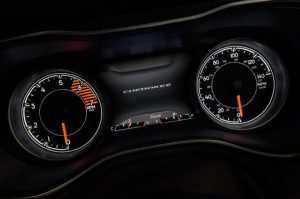
And there’s a third option – the new-for-2019 2.0 liter turbocharged four cylinder. It makes 271 hp and 295 ft.-lbs. of torque. That’s 56 more ft.-lbs. of torque than the V6 makes – and the four makes that torque lower in the powerband, at 3,000 RPM vs. 4,400 RPM. It does so by snugging the turbo as close to the exhaust ports of the cylinder head as possible, so as to build boost as quickly as possible.
It burns regular unleaded gas, too.
All three engines are paired with a nine-speed automatic transmission with a pretty aggressive 4.71 first gear to leverage the engine’s power for a strong launch – with multiple overdrive gears higher up to drop the revs when you’re cruising, in order to cut fuel consumption.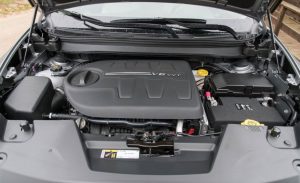
All three engines are not bad on gas – and certainly par for the class.
The base 2.4 liter four is capable of 22 city/31 highway (FWD models) which is right there with the FWD versions of the RAV4 (23 city, 30 highway) and CR-V (27, 33 highway) and others in this class.
But acceleration/capability with the available V6 – or the turbo four – outclasses others in this class. Without burning much more gas.
The V6 Cherokee with FWD rates 20 city, 29 highway – a difference without much distinction vs. the smaller (and much less powerful) 2.4 liter four, as well as rivals’ fours.
And the Cherokee’s new top-of-the-line turbo four is capable of 23 city, 31 highway for FWD versions – better mileage than the V6 and the base four and only slightly lower than the take-them-or-leave-them fours in rivals like the RAV4 and CR-V.
The Ford Escape offers a bit more underhood gumption than the RAV4 or the CR-V, if you buy its top-of-the-line 2.0 liter turbocharged four. But even so, it maxes out at 245 hp – well below the Cherokee’s 270 hp – and the Ford (like the others) comes up very short when it comes to capability. It can tow more (3,500 lbs. with the turbo four) than the RAV4 and CR-V but it can’t rock crawl – and isn’t set up for serious off-road work.
All the crossovers in this class are available with light-duty all-wheel-drive systems, which mostly send power to the front wheels. They don’t have driver-adjustable terrain modes or low-range gearing or locking differentials.
The Jeep does.
The first four-wheel drive system – Active Drive I – also features an automatic rear-axle disconnect system which lets the rear wheels freewheel (to reduce drag and so increase fuel efficiency) when traction is good and it’s not necessary to power all four wheels. The Jeep is the only vehicle in this class that can completely decouple its rear axle.
You get the efficiency advantage of the FWD layout – with the “on-call” capability of 4WD.
For more capability, there’s Active Drive II – which adds a two-speed Power Transfer Unit that works very much like a truck-type 4×4 SUV’s two-speed transfer case; the difference is there’s no separate center differential. Instead, the PTU mounts up front as part of the engine/transaxle and uses a planetary gearset to achieve the same effect. The system has a 4-Low range, just like a truck-type 4×4 system – with a mud-bogging 2.92:1 gear reduction ratio as well as a 51.2:1 ratio when rock crawl mode is selected.
It is also possible to disconnect all four wheels from the engine by engaging Neutral – which makes it possible to tow the Jeep behind an RV with all four wheels on the ground.
This is another functional feature unique to the Cherokee.
Hybrids make so much more sense than pure electric cars. No angst about short range – and long recharge times. You carry your recharger – the gas engine – with you. So you can refuel – and be back on the road in minutes. Yet you still use less fuel.
Similar sensibility here.
The Cherokee is as adroit on-road as it is capable off-road. It isn’t clumsy in the curves. It doesn’t lumber and sway. Part of the reason for this is its height-to-width ratio. It is relatively low-slung (66.2 inches tall) but proportionately very wide-tracked (73.2 inches), which is a stability enhancer.
For perspective, the less-capable RAV4 is 67.1 inches tall and only 72.6 inches wide. It feels top-heavier as a result, more like a 4×4 SUV in the curves than a crossover. But it can’t cross over nearly as much as this Jeep can.
Another stability enhancer is balance. Which is a function of weight distribution.
Most crossovers – being based on FWD cars – are front-heavy. The weight of the engine/transaxle sits right over the front wheels – with not much weight behind the front wheels. Toss that into a decreasing radius curve at speed and the front end is prone to plowing toward the inside of the curve (chronic understeer) while the back end tends to lift and incline toward swinging wide during hard braking.
Neither are boons to stable, confident-feeling handling.
The Jeep – while also based on a platform shared with FWD cars – is better balanced. There’s still more weight up front (58 percent for the FWD version) than would be the case if this were based on a rear-drive layout (engine front-to-back, transmission behind that – and a rear axle out back) there is a counterbalancing 42 percent spread out toward the rear.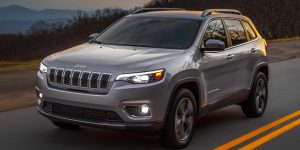
That plus the wide stance and low height gives the Jeep a handling/stability edge over its rivals you’ll notice right away both in the curves and at high speeds on the highway. It doesn’t get knocked around by the wind as much and it’s not necessary to keep a firm two-handed grip on the wheel to keep the thing on track.
Visibility is good, too – in part because the A pillars at either side of the Cherokee’s windshield angle forward more steeply than most (to give the Jeep its sexy low-slung profile) and so do not obstruct the view to the side. This is a big problem in many new vehicles, not just new SUVs.
It’s not a problem here.
Nor the view to the rear – another Unusual Thing. The Cherokee’s back glass isn’t too small and doesn’t slope to sharply – so you can see what’s behind you. The back-up camera is there if you want it, but you don’t necessarily need it – as you do with some other vehicles.
Now add power.
The Cherokee – with the V6 or the new turbo four – is quick and fast, two things the CR-V and RAV4 are not.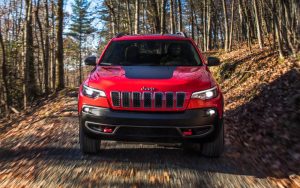
The one thing you may not like is the automatic stop/start system – which Jeep bundles with the turbo four and the V6. You can turn it off – there’s a button on the center stack – but you have to remember to do that every time you go for a drive. If you forget, the engine will automatically cut off when you come to a stop. It’ll just as automatically re-start once you take your foot off the brake and press on the gas. But many people do not like the engine stop-starting (including me) no matter how quickly or smoothly – because it’s never as quick or as smooth as just leaving the engine running. Also, when you leave the engine running, there’s no worry about wearing down the battery (or the engine) at a faster-than-normal rate on account of all that stopping and starting.
Don’t blame Jeep, though. Blame Uncle. All car companies are adding this system to their vehicles to fractionally reduce gas consumption and – lately, they’re talking this up in the press materials – as a way to reduce “carbon emissions.”
God help us all.
AT THE CURB
The wide and low stance also looks good.
From the front, especially, the Cherokee remains the most distinctive-looking vehicle in the segment.
But you’ll have to look closely to notice the changes to the look.
The basic shape is the same, but the 2019 is just under an inch longer overall (183.1 inches vs. 182.3 for the 2018) and the wheelbase has been lengthened just slightly to 106.4 inches from 106.3 previously.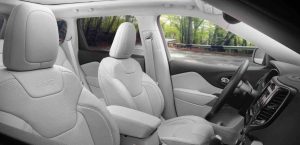
Inside, the look is meaty and substantial – in keeping with the outside look. It’s not just the steering wheel that’s thick and meaty; the dash and door panels are, too. Even the shifter handle is meaty. It looks and feels manly and rugged – in keeping with the theme and the capabilities.
The only thing that’s not substantial-feeling (or looking) are the icons for some of the functions on the UConnect touchscreen. These could definitely be improved by making them larger – and so easier to touch (especially if you’re wearing gloves).
That aside, there’s a lot to like here.
Including a much roomier back seat than several others in this class, including the RAV4 and Escape – which have only 37.2 inches and 37.3 inches of second row legroom (respectively) vs. 40.3 inches for the Jeep.
There is, however, one category of capability where the Jeep comes up short vs. pretty much every crossover in its size class:
Cargo room.
Though there is more room this year – 27 cubic feet behind the second row vs. 24.6 previously – that’s still much less than the RAV4 (38.4 cubic feet) or the CR-V (39.2 cubic feet) or the Escape (34 cubic feet). Fold the Cherokee’s second row and the space opens up to 54.7 cubic feet but that’s still well below the Honda’s cavernous 75.8 cubic feet with its second row down, the Toyota’s 73.4 cubic feet and the Ford’s 68 cubic feet.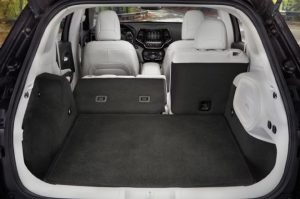
And the reason for this has to do with the Jeep’s much higher capabilities.
The additional gear for the additionally capable Active Drive system takes up additional room under the floorpans, leaving less room for cargo above the pans – very much like the “real” SUVs the Jeep so closely emulates, to the extent it almost is.
THE REST
Jeep doesn’t “up-sell” you.
Well, not much.
If you want the V6, for instance, you do not have to buy the more expensive Limited, Trailhawk or Overland trims. The turbo four is the only engine you can’t buy in the lowest-cost Latitude trim.
Jeep also lets you buy the Active Drive I 4WD system with the base Latitude trim – and with the standard 2.4 liter engine. You don’t have to buy the V6 before you’re allowed to buy 4WD.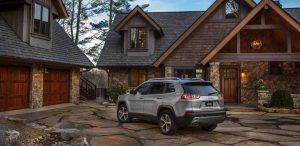
The most aggressive version of the Active Drive II system (with locking differential) is limited to the Trailhawk – but you’d only want that hard-core capability in something like the Trailhawk anyhow.
It’s a shame, though, the Jeep can’t sell you a diesel engine. It would be the perfect engine for a vehicle like this, whether on-road or off. Huge torque – and high mileage. Probably that’s why a 2.0 liter turbodiesel engine is available in Europe (see here).
As for why it’s not available here . . . ask Uncle.
THE BOTTOM LINE
This “hybrid” makes a lot more sense than some of the real ones.
. . .
Got a question about cars – or anything else? Click on the “ask Eric” link and send ’em in!
If you like what you’ve found here, please consider supporting EPautos.
We depend on you to keep the wheels turning!
Our donate button is here.
If you prefer not to use PayPal, our mailing address is:
EPautos
721 Hummingbird Lane SE
Copper Hill, VA 24079
PS: EPautos magnets – they’re back! are free to those who send in $20 or more to support the site. Also, the eBook – free! – is available. Click here. Just enter you email in the box on the top of the main page and we’ll email you a copy instantly!






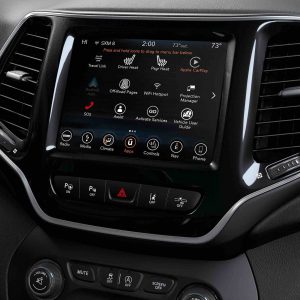










Not sure about the 2019, but some earlier models needed an engineering change to allow the Cherokee to be towed on its own four wheels. It turns out that the electric steering system needs to be on during towing. That requires the insertion of a fuse before every trip. And it requires that the system be energized from the towing vehicle to avoid discharging the Cherokee battery. That requires a wiring change and a switching procedure before every trip. Then the procedure must be reversed before you can drive the Cherokee again.
While the turbo can run on 87 octane, 91 is recommended for the best performance. So the hp/torque and mpg ratings would be somewhat less with 87. This is the same engine also debuting in the new Wrangler.
Skip the crossover. Buy a used body-on-frame SUV with real off-road cred. The prices are coming down.
https://www.youtube.com/watch?v=7_7STBtFEWk
Long term update on my 2016. With 26K miles I’m still liking mine. Still don’t like the U-Connect system even after a few updates. It stays very well planted on mud and washboard, but some of the features like hill descent are pretty useless. Mileage goes south quickly with the roof rack rails installed, and hasn’t really improved much beyond 26 MPG highway even after break-in. The transmission is interesting in that it does’t really hunt around much, and is geared so low in first that it jumps off as soon as you tap on the gas which takes some getting used to. I rarely see it go over 7th gear and has only gone into 9th when going 80 in Utah.
And the less than stellar but not unexpected fuel economy is made worse by the 13 gallon fuel tank. One of the reasons I bought this vehicle is for towing a light travel trailer. But after seeing the mileage when empty I’m wondering just how useful it will be for towing anything more than the smallest teardrop. When I do get a trailer I’ll be sure to add on a jerry can too.
I actually use the adaptive cruise control. Most trucks out here hold at 70 MPH when the speed limit is 75, and often times I get stuck behind the truck because no one leaves space to let anyone else get into the passing lane. The vehicle does a pretty good job of maintaining distance and smoothly adjusts. But it also tends to hunt around for a space cushion when passing, which might leave you doing 70 in the passing lane so you still need to override. Going downhill the cruise will downshift and use the brake to maintain speed fairly well too. Lane departure is pretty useless and annoying because it doesn’t really do anything. If you go more than a few hundred feet without moving the steering wheel it will warn you to “put your hands on the wheel” even in a long straightaway. And it often fights you when you want to take a line on a turn it doesn’t agree with.
The interior is still in very good shape, and easy to keep clean. I keep all the seats folded down so there’s lots of space for my bicycle, luggage and everything else I might need for a weekend trip. Driver seat is very adjustable and the steering column is telescoping and tilt. Air con motor is very strong and will cool down the vehicle in a few minutes. I’m used to using the push-to-start button, along with the start-stop override button and parking brake release when starting. A simple key switch becomes three buttons thanks to Uncle.
And then there’s the U-Connect system. I know it got better in 2017 now that it comes with Android Auto and CarPlay, but the straight U-Connect system is not very good. I got a free year to try it out and let it lapse just because the cost is so high, basically like having another cell phone bill. The maps are nice in that you get directions in between the speedo and tach, but the database is lacking and unless you pay for U-Connect Access (or maybe Sirus-XM, not sure which) you don’t get traffic data. Not that it was all that accurate anyway. Apple Maps is better, and that’s saying something. Because the radio is part of the overall entertainment/navigation/HVAC controls you cannot turn it off. So I had to program Sirius-XM channel 0 (radio ID) and leave it on to not get blasted out by static or a radio station. And the reason you might be blasted out is because if you use the USB-ipod connection, which is what I normally do, if you don’t plug in your phone it will default to the radio at whatever volume.
But the things I’m not complaining about are why I like it. I can get just about anywhere I want, in a very comfortable vehicle. There’s little road and wind noise, no rattles or shakes and plenty of power. With all the seats down I can stretch out and take a nap if I want. Proper full-size spare tire (which might be why the fuel tank is so small). It does compare favorably with higher-end SUVs like VW and Audi (which I test drove). And there’s a pretty good aftermarket developed for things like steel rocker panels (the factory ones are plastic) and you can lift it another inch or so without screwing up the handling. If you’re looking for an SUV I’d at least give it a test drive.
What’s the 0-60 for the turbo 4?
Looks like a nightmare on wheels. Skip
Hi Brazos,
I’m not a huge fan of the looks, but the thing can actually do real stuff – I mean, other than carry kids and groceries!
I love the look of it on the outside, actually test drove one with the wife last year. The inside and under the hood… quite the nightmare there.
Yes, it is a very capable, practical package. Better in this way than all others in its class.
Unfortunately, from some angles, it is really homely. When originally introduced, many people hated its face. Personally, I think the face is OK…not great, but no problem.
But the side view, especially front three quarter, is weirdly unsightly.
The Cherokee is not, like some cars, so ugly I would “never be seen in it.” But it’s too homely to own.
The Trailhawk front looks pretty good when you consider that the shape is for approach clearance not aerodynamics. The back reminds me of a wide old lady in a girdle though.
The redesigned front styling is much better, though I still prefer the classic XJ. They got rid of the separate headlight/ turn signal units and the new combined unit isn’t so slit like. The nose is more muscular and the crease in the grill doesn’t appear as severe. Makes it look more masculine than the “shark” nose.